Detection
of superhumps in dwarf nova NSV 1485
durings the Sep 2007 superoutburst
The poorly studied cataclysmic variable NSV 1485 was
reported to be in outburst on Sep 10th, 2007 by
Denis V. Denisenko (Space Research Institute IKI),
using the 1.5-m Russian-Turkish Telescope (RTT150).
The object is located at RA = 04h12m36.89s, Dec. =
+69°29'06.4" (J2000.0). A CCD image identifying the variable is
shown below. NSV 1485 was originally discovered by
T. Meshkova on Moscow photographic plates in 1944 (Astron.
Tsir. 26, p. 4) as a variable of unknown type
with a magnitude range of 12.9-<14.5.
Based on 6 nights of photometric
observations between 2007, Aug 26th and 2007, Sep
07th, during quiescence of the variable, D.
Denisenko found an orbital period of either
0.0717d and 0.0771d (i.e., 14 and 13 revolutions per
day). It was impossible to further distinguish
between these two aliases.
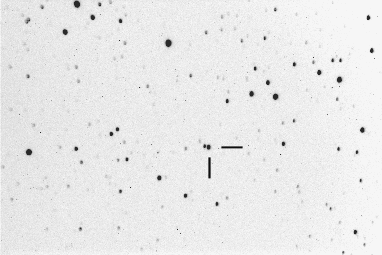
11 Sep 2007 at 23h34m UT. (c)
Tonny Vanmunster
The marked object is NSV 1485. The brightest star in
the image is GSC 4332:777.
Follwing the announcement of this rare outburst, I decided to start
a CCD photometry session on 2007, Sep 11/12, using a 0.35-m f/6.3
telescope and ST-7XME CCD camera (working
unfiltered). I repeated similar unfiltered CCD
sessions on the 2 following nights, resulting in the
below lightcurve.
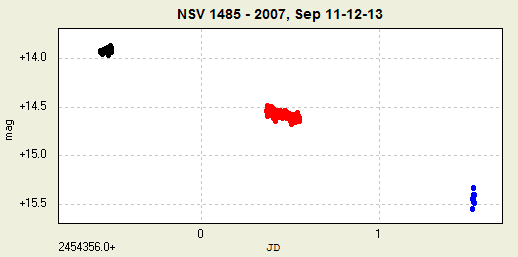
The light curve shows a decline by 0.8
mag/day, but no apparent modulations in any of the
datasets. An extensive analysis using various period
analysis methods in Peranso
did not reveal any strong signal.
From precursor outburst to
superoutburst
At a moment that everyone was
assuming that the variable had returned to
quiescence, Patrick Schmeer reported his detection
of another outburst of NSV 1485, on 2007, Sep 19th.
When I received Patrick's phone call (thanks Patrick
!) around 10 PM
local time that evening, skies were completely
overcast, but the weather satellite images showed a
possible clearing later that night. I woke up around
0h UT (Sep 20th) and saw a clear sky.
It remained clear for about 3 hours,
during which I started an unfiltered CCD photometry
session on NSV 1485, using again a 0.35-m f/6.3
telescope and SBIG ST-7XME CCD camera. The resulting
lightcurve, based on a 2.5 hrs session, is shown
below and clearly reveals the presence of
superhumps, hence classifying NSV 1485 as a new
UGSU-type dwarf nova. Using Peranso's ANOVA
method, I find a superhump period value of 0.076 +/-
0.001d, and an amplitude of about 0.15 mag. The
period window and phase diagram are shown below. My
superhump period value seems to favor the orbital
period alias of 0.0771d (but see the discussion on
the superhump refinement below).
NSV 1485's precursor outburst
occured about 10 days before this main
superoutburst. A similar combination of outbursts
was recorded during the 1998 outburst of QZ Vir (aka
T Leo). QZ Vir underwent a supposed precursor
outburst on 1998 Apr 2, followed by a superoutburst
10 days later.

CBA Belgium Observatory lightcurve
of NSV 1485 - unfiltered CCD observations - 2007,
Sep 19/20

ANOVA period window depicting the
superhump period at 0.076 +/- 0.001d
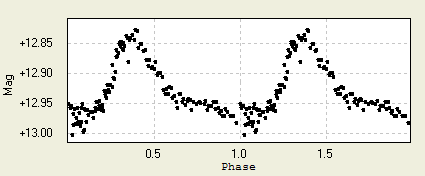
Phase diagram corresponding with
the period at 0.076d
Additional CBA observations of NSV 1485
Two long observation sets of NSV 1485 were
obtained on Sep 21/22, 2007, by
CBA New Mexico (Tom Krajci) and CBA Belgium
Observatory (Tonny Vanmunster). The two sets cover a
total of 1059 observations, over a time span of 16.7
hours, with only a small gap in between the two
sets.
Combined with my Sep 19/20 obs, the CBA dataset
for NSV 1485 now comprises 1191 superoutburst
observations. Using Peranso's
implementation of the ANOVA method (A.
Schwarzenberg-Czerny), I find a superhump period
of 0.07421 +/- 0.00010d. See the period
window below. This is slightly shorter than the
value I found on Sep 19/20 (see above), but which
was based on a *much* shorter timeline.
The amplitude derived from all CBA observations
is about 0.18 mag. The phase diagram (see below)
shows a small dip on the descending branch of the
superhump modulation, but I'm not sure how to
interpret this. Further observations might tell.
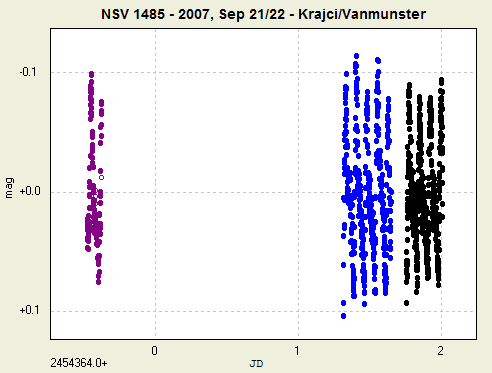
NSV 1485 superoutburst lightcurve
combining CBA observations of Tom Krajci (CBA New
Mexico, dark obsset)
and Tonny Vanmunster (CBA Belgium Observatory,
purple & blue obsset).
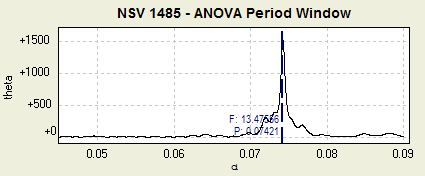
ANOVA period window depicting the
superhump period at 0.07
421 +/-
0.0010d
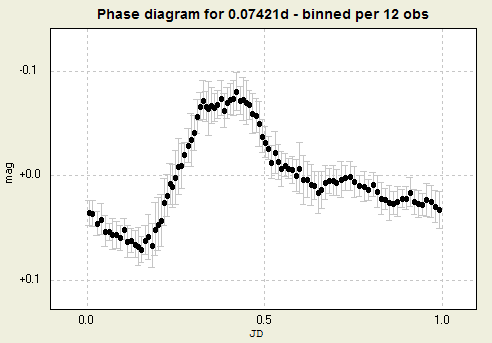
Phase diagram corresponding with
the period at 0.07
421d,
binned per 10 observations.
Note the small dip on the descending branch of the
superhump wave.
|